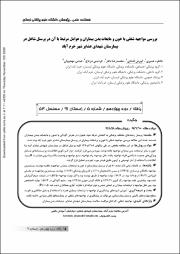Study of occupational exposure to blood and body fluids of patients and related factors in health care workers employed in Khorramabad Shohada Ashayer hospital
(ندگان)پدیدآور
Anbari, khaterehGhanadi, koroushNazer, mohammad rezaDortaj, fardisMahdavian, abbasنوع مدرک
TextResearch
زبان مدرک
Englishچکیده
Background : Health care workers, as their profession require, are constantly exposed to patients, infected blood and body fluids. The main objective of this study was to determine the epidemiologic and clinical aspects of occupational exposure to patients, blood and body fluids and related factors in health care workers of Shohada Ashayer hospital.
Materials and Methods: In this cross sectional study, during 2010-2011, all Shohada Ashayer hospital personnel, who had been exposed to blood and other body secretions of patients were studied. The data collection tool was a questionnaire containing demographic information of the exposed persons, the exposure way, source of contamination, cause of exposure and hepatitis B vaccination status. The data were analyzed using descriptive statistics and Fisher's exact test.
Results: In the mentioned interval of time, 80 health care workers had been exposed to blood and body fluids. The highest rate of occupational exposure was found among nurses (32.5%), medical students (20%) and interns(11.3%). These exposures had occurred most commonly in the emergency ward (41.3%). Percutaneous injury was reported in 96.3% of the cases. Most cases (52.5%) were reported in the morning shift.The most causes of body secretions expoture in our subjects were IV catheters(26.3%) and sheaths the needle(22.5%). Sources of infection was unknown in 56.3% of the exposed personnel. No significant statistical difference was observed between cause of exposure to patients, body secreations, and personnels profession and sex.
Conclusion: Training in prevention methods of exposure to patients, discharge by use of protective barriers, and enhance the clinical competency of health care workers can play an important role in the prevention of occupational exposures.
کلید واژگان
Occupational exposuresHealth care workers
Shohada Ashayer hospital
Patients
body discharge
شماره نشریه
5تاریخ نشر
2013-02-011391-11-13





